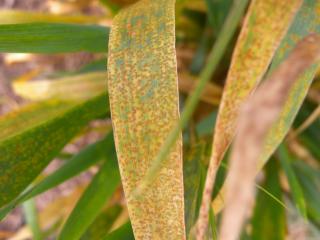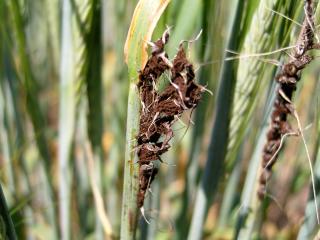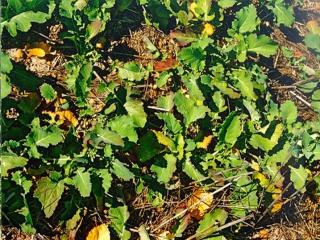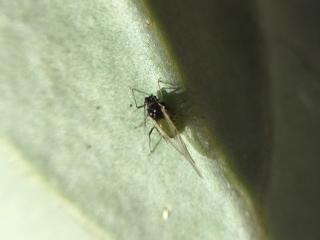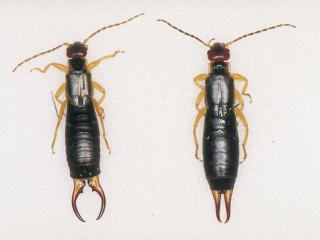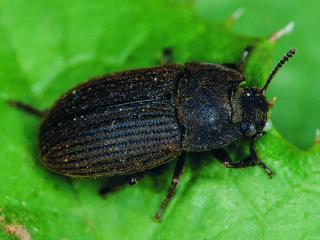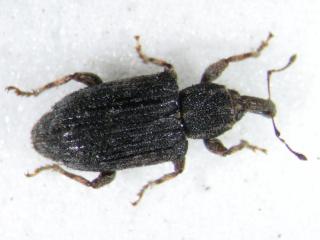Leaf rust and loose smut in barley regrowth down south
- Kendenup
- Albany
John Blake (Stirlings to Coast Farmers) has found barley leaf rust (BLR) and loose smut in the West Kendenup area on Rosalind barley regrowth at the heading stage.
Plant pathologist Kithsiri Jaysena (DAFWA) has also reported finding BLR on Flinders barley regrowth at a farm on Kojaneerup West Road in the shire of Albany. The barley is currently being grazed by cattle.
Rust samples have been sent to the University of Sydney for pathotype testing from both locations. For more information on rust pathotype testing and the Australian Cereal Rust Survey refer to the Rust Bust website.
Barley leaf rust
Leaf rust infection has been found in volunteer barley in several areas of the lower Great Southern which is an indicator that this disease could again be problematic for barley growers in this region for 2017.
For more information on BLR and how to manage it refer to DAFWA’s Diagnosing barley leaf rust page and Barley and wheat leaf rust warning for 2017 PestFax Issue 4 article.
Barley loose smut
These infected plants do not pose a risk for this seasons crops. Barley loose smut is a fungal disease affecting seed heads, which can cause yield losses. In plants grown from infected seed, florets are replaced with a compact mass of dark brown-black powdery spores at heading. These spores are dispersed by wind to infect adjacent plants and produce the next generation of infected seed. Infection is favoured by rainfall and high humidity during flowering. In the paddock look for scattered plants with black heads or bare flower stalks.
The fungus is managed by sowing clean seed or using registered fungicidal seed dressings.
Growers are advised to ensure all seed sown receives an effective seed treatment as infected plants produce no grain resulting in lost yield. The percentage yield loss is roughly similar to the percentage of plants infected. Some of our markets also have a zero tolerance for this disease.
For more information refer to DAFWA's Diagnosing barley loose smut page.
For more information contact Kithsiri Jayasena, Plant Pathologist, Albany on +61 (0)8 9892 8477.
Canola and cereal virus infection in volunteers
As part of a survey of virus infection in volunteer crop plants and weeds from across the wheatbelt, DAFWA Crop protection agronomists at Albany, Esperance, Merredin, Northam and Geraldton have been submitting cereal, canola and weed samples for virus testing.
Virus infection in crops at early growth stages poses the greatest risk of yield losses from these virus diseases. This can occur when virus vectors such as aphids and mites spread virus from infected volunteer plants or weeds to newly emerging crops. Ensuring that volunteer plants are grazed out or completely dead prior to crop emergence will significantly reduce virus inoculum reservoirs and risk associated with these diseases.
Beet western yellows virus
- Toodyay
- Irishtown
Plant virologist Ben Congdon (DAFWA) reports that at the time of writing, canola or wild radish had been submitted from more than 30 sites from a wide range of Wheatbelt locations, with beet western yellow virus (BWYV) detected in wild radish from two sites at Toodyay and Irishtown. Although BWYV was below detection level (100 plants) in most of these samples, infection reservoirs may still be present at all sites tested. These reservoirs will increase in magnitude following the build-up of autumn aphid vector populations on wild radish.
For further details on identifying and managing this virus refer to DAFWA’s Diagnosing beet western yellow virus in canola.
Wheat streak mosaic virus
- Esperance
- Lake Grace
- Corrigin
From approximately 25 sites of cereal volunteers, wheat streak mosaic virus (WSMV) was detected at low levels from three sites in the Esperance, Lake Grace and Corrigin regions. These levels of detection are similar to previous seasons and indicate that low levels of inoculum are present in some green bridge volunteers. In paddocks or regions where this disease has been problematic previously, specific attention to complete removal of volunteers in or adjacent to newly emerging crops is recommended. Barley yellow dwarf virus (BYDV) had not been detected in any samples submitted.
For further details on identifying and managing wheat steak mosaic virus refer to DAFWA's Diagnosing wheat streak mosaic virus and Wheat streak mosaic virus and wheat curl mite.
Green bridge insect or disease observations can be reported through the MyPestGuide Reporter app, using the Green bridge survey tab.
Volunteer crop and weed regrowth and early sown crop samples can be submitted to DAFWA virology for virus testing.
For further information contact South Perth based plant virologists Ben Congdon on +61 (0)8 938 3499 or Brenda Coutts on +61 (0)8 9368 3266.
Green peach aphids are colonising on imidacloprid treated canola
- Jennacubbine
- Muresk
- York
- Toodyay
- Tammin
- Cunderdin
Entomologist Dusty Severtson (DAFWA) has found low numbers of winged green peach aphids (GPA) on leaves of early flowering canola volunteers near Jennacubbine. He also found low numbers of winged GPA on a poorly germinated canola crop near Toodyay.
Dusty also found low numbers of GPA, cabbage aphids and diamondback moth caterpillars on seedling canola in a poorly germinated crop near Muresk. Dusty found clusters of GPA and cabbage aphids on volunteer seedling canola near York.
Dan Taylor (DKT Rural Agencies) has found low numbers of GPA on Bonito and 43Y23 canola seedling crops near Tammin and Cunderdin. The seed had been treated with imidacloprid seed dressing and it is a worry that GPA are surviving on such small seedlings. Some crops are cotyledon to two leaf stage while others are 8-10 leaf and outgrowing much of the insect pressure. Dan said he will continue to monitor crops to see if the aphids increase in populations.
For more information on GPA visit DAFWA’s Aphid management in canola crops.
For more information on GPA insecticide resistance refer to the recent PestFax article Green peach aphid control in canola: Are we running out of options?
For more information contact Dustin Severtson, Development Officer, South Perth on +61 (0)8 9368 3249.
Earwigs and vegetable beetles in canola
- Ongerup
A grower at Ongerup is having problems with earwigs and vegetable beetles in his emerging canola crops. As the grower’s canola germination is patchy it is difficult to distinguish between seedling damage or death caused by the insects or whether some seed had simply not germinated yet.
European earwigs are a recurring pest on properties. These pests do not just cause damage to canola at the emergence but have also been known to strip canola at the 10 leaf stage to the stem.
Lab trials conducted by DAFWA entomologist Svetlana Micic have shown that vegetable beetles will cause damage to crops if day temperatures are 20°C and above. As soon as the cold, wet winter conditions prevail ie day temperatures of 15°C and below, damage by the vegetable beetle is expected to cease.
Vegetable beetles can build up to very high populations under no-till systems and high stubble residues.
Insecticides especially chlorpyrifos or alphacypermethrin applied at the highest registered rates do have efficacy against European earwig as a contact only. However European earwigs can be difficult to control as they hide under stubbles. Sprays applied at night have worked better than sprays applied during the day as earwigs are more active at night.
Vegetable beetles are very tolerant of insecticides. Svetlana says that currently registered insecticides for use on false wireworm (includes vegetable beetles) on canola such as chlorpyrifos (500g a.i) at 1.0-1.5L/ha with some labels stating that the application should be incorporated into the top 50mm of soil, have suppressed damage from vegetable beetles, however, many growers and agronomists have reported these rates did not cause vegetable beetle mortality rather beetles were 'subdued' and this allowed the crops to out grow the damage.
For more insecticide information refer to DAFWA’s Autumn Winter Insecticide Guide 2017.
Further details about these pests can be found at DAFWA’s Diagnosing European earwig and Diagnosing vegetable beetle damage.
For more information contact Svetlana Micic, Research Officer, Albany on +61 (0)8 9892 8591 or Dustin Severtson, Development Officer, South Perth on +61 (0)8 9368 3249.
More weevil and mite activity
Desiantha weevil
- Belka Valley
David Stead (Anasazi Agronomy) reports that desiantha weevil (or spotted vegetable weevil) are active in early germinating to four leaf canola crops in Belka Valley. As they are causing considerable damage the grower will spray them.
Desiantha weevil larvae attack cereals at the seedling and tillering stages. They feed underground on germinating seeds, and bore into the stems of seedlings and tillers, often killing plants or resulting in abnormal and stunted growth. In contrast, canola is mostly damaged by adults. They chew cotyledons, leaves and stems of canola plants and may eat small plants down to ground level.
Desiantha weevil adults are mottled grey-black in colour with grey flecks on the abdomen and have the typical elongated weevil snout. They grow up to 7mm long and are flightless. Larvae are white, legless grubs with orange-brown heads and grow to 8mm in length.
For more information on desiantha weevils see DAFWA’s Diagnosing weevils in canola or Cesar’s Spotted vegetable weevil PestNote.
Mite activity
- Kellerberrin
- Narrogin
Dan Taylor (DKT Rural Agencies) reports that he hasn’t seen any redlegged earth mites yet, indicating that the cold temperature requirement for eggs to hatch has not been met yet in some areas. He noted that low numbers of bryobia mite had been seen amongst seedling canola crops north west of Kellerberrin.
Hilary Wittwer (Planfarm) reports finding balaustium mite in a Bonito canola crop near Narrogin. The crop was at the cotyledon growth stage and mite numbers were not at damaging levels. The crop will be monitored and Hilary is hoping that after receiving more rain the canola will grow away from them.
To view previous mite reports received this season see DAFWA’s PestFax map.
More information on mites can be found at DAFWA’s;
For more information contact Dustin Severtson, Development Officer, South Perth on +61 (0)8 9368 3249.
Tips on how to identify insects in emerging crops
During autumn, changing seasonal conditions trigger a burst of activity from a range of crop establishment pests, and also beneficial species.
As crops emerge, it is important to remember that differences in pest biology, as well as seasonal differences, mean that no one tactic or approach will effectively control pest issues in all situations. Therefore, frequently checking crops during the first 3-5 weeks is a key to early detection of pest issues and intervention as necessary to ensure crops get away to a healthy start.
When checking crops sometimes pest damage is visibly obvious but finding and identifying what insect pest, or combination of pests, is causing the damage may not always be so simple.
The following tips might be useful to identify damaging insect pests in emerging crops;
- Look up and down the seeding rows for missing plants that may have been chewed off at the base or plants with visible chewing damage.
- Look for insects around and under chewed or missing plants. Don't forget to check under the stubble in the inter-rows.
- What type of damage has the plant sustained? Understanding the preferred feeding methods and mouth parts of insects can help narrow the lists of culprit insects. For example chewing damage above or below ground is the feeding method favoured by caterpillars, European earwigs, weevils and other beetles. Sucking-type damage appears as wilting and yellowing of plants and is favoured by aphids and Rutherglen bugs who have piercing and sucking mouthparts.
- Still can't find a pest? Place a pitfall trap near the damage, this is just a plastic cup dug into the ground so the top is flush with the soil surface. Put about 10mL of water into it and come back after 24 hours. This has been especially useful in detecting the presence of weevils, slaters and European earwigs. European earwigs are one of the few pests that if numbers are high, can damage well established crops especially if they chew through the stem.
- Have you found an insect in the paddock that you have not seen before? It could be an incidental or it could be a new pest species. Consider taking the time to get it identified. It is hard to identify an insect from a verbal description. But there are a few things you can do. Have a phone or tablet that takes photos? Take a photo and email it to Dusty Severtson. We also encourage taking a photo and attaching it to your report when using the PestFax Reporter app.
DAFWA entomologist Svetlana Micic goes into more detail about monitoring crops for insect damage and identifying them in the department’s How to monitor for early season pests YouTube video.
If you do find insects in the paddock make sure they are correctly identified as not all insects that are caught may be crop pests.
The department offers a multiple of free insect identification services and for more information on these refer to the PestFax article Get your insects identified for free with DAFWA.
For more information on monitoring insects in emerging crops refer to the department’s Monitoring insects and other crop pests.
For more information contact Svetlana Micic, Research Officer, Albany on +61 (0)8 9892 8591 or Dustin Severtson, Development Officer, South Perth on +61 (0)8 9368 3249.

